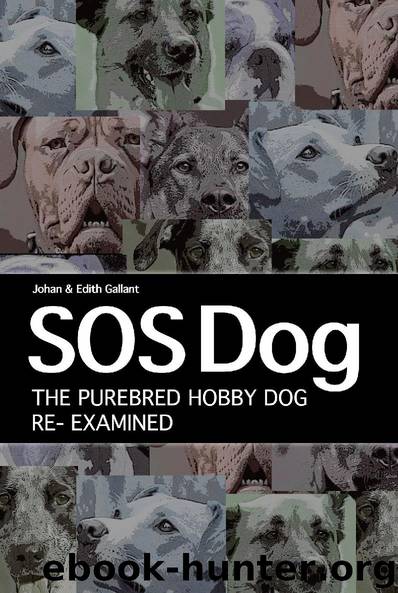SOS Dog: The Purebred Dog Hobby Re-examined by Johan & Edith Gallant

Author:Johan & Edith Gallant
Language: eng
Format: epub
ISBN: 9783942335935
Publisher: Kynos Verlag
Most books dealing with a particular dog breed start with the history of that breed and try to link its ancestry to dogs from the Renaissance, the Middle Ages, or even ancient cultures, often based on representations of old paintings.
Modern dog fanciers and certainly the public at large are mostly unaware of the fact that the majority of our present day dog breeds resulted from what is commonly called a “founder group.” This refers to an indefinite (small) number of dogs that had been selected on preferential grounds to form the basic genetic pool from which a “breed” would be extracted. The creation of a breed with specific reoccurring particularities can only be achieved by bringing these particularities together in an endeavor to fix them genetically, i.e., to obtain individuals that are homozygous for a number of particularities and breed true for these features. In layman’s terms, this means that an individual or a small group of fanciers, based on personal preferences, select some dogs within a set population or geographical race. They isolate this founder group to start a tight inbreeding program to establish and thereafter perpetuate the particular dog type of their dreams. This is the principle on which the large majority of our approximately 350 recognized modern dog breeds have been achieved. All these breeds are described in an acknowledged “prescriptive” breed standard. Such breed standards are prejudicially man-made, as are the breeds that are artificially selected in respect to such standards. Once the limited founder group has produced a sufficient number of offspring, the respective national kennel organization closes the “foundation stock register.” The new breed obtains national and international recognition, and its offspring become eligible for registration in official studbooks worldwide.
Besides the fact that the majority of our breeds has been extracted from a handful of “preferential” dogs and was created between 1873 and 1925, the technique of inbreeding and line-breeding maintained momentum and currently still applies, largely in the purebred dog breeding fraternity. Inbreeding means that the two partners are first degree relatives, i.e., brother-sister or parent-offspring combinations. Line-breeding is slightly less rigid but assures that mutual ancestors occur on paternal and maternal sides of the pedigree.
Inbreeding and line-breeding are powerful instruments and virtually the only tools that can be used to create a new breed artificially and to perpetuate it. However, their applications are not without dangers. The consequences can be summarized as follows.
1. From a technical point of view, we must bear in mind that genes do not only carry qualities that are sought after. Also less desired characteristics and absolute faults are prone to be inherited simultaneously. Complicated linkage among genes situated on the same chromosome make a clear prognosis impossible.
2. Modern cynotechny, from its onset and even more today, aimed mainly at outward appearance and fashionable aspirations. This approach means that the breeding goals were often inspired by the mode or the cultural trend of the day and were not necessarily to the benefit of the breed under manipulation. Moreover,
Download
This site does not store any files on its server. We only index and link to content provided by other sites. Please contact the content providers to delete copyright contents if any and email us, we'll remove relevant links or contents immediately.
| Breeds | Care & Health |
| Training |
Finding Gobi by Dion Leonard(2811)
Grumpy Cat by Grumpy Cat(2719)
A New Earth: Awakening to Your Life's Purpose by Eckhart Tolle(2626)
The Silkworm by Robert Galbraith(2465)
Tippi by Tippi Hedren(2208)
End of Days by Sylvia Browne(2152)
Total Cat Mojo by Jackson Galaxy(1989)
Backyard Chickens Beyond the Basics by Pam Freeman(1922)
Penguin Bloom by Cameron Bloom(1911)
The Animals Among Us by John Bradshaw(1843)
The Ultimate Pet Health Guide by Gary Richter(1742)
All Things Bright and Beautiful by James Herriot(1728)
The Plant-Based Dog Food Revolution by Mimi Kirk(1694)
Vet in Harness by James Herriot(1680)
Doggy Desserts: 125 Homemade Treats for Happy, Healthy Dogs by Cheryl Gianfrancesco(1671)
Dog Years by Mark Doty(1658)
Cesar's Way by Cesar Millan(1656)
Chicken Soup for the Ocean Lover's Soul by Jack Canfield(1622)
Animal Speak by Ted Andrews(1587)
